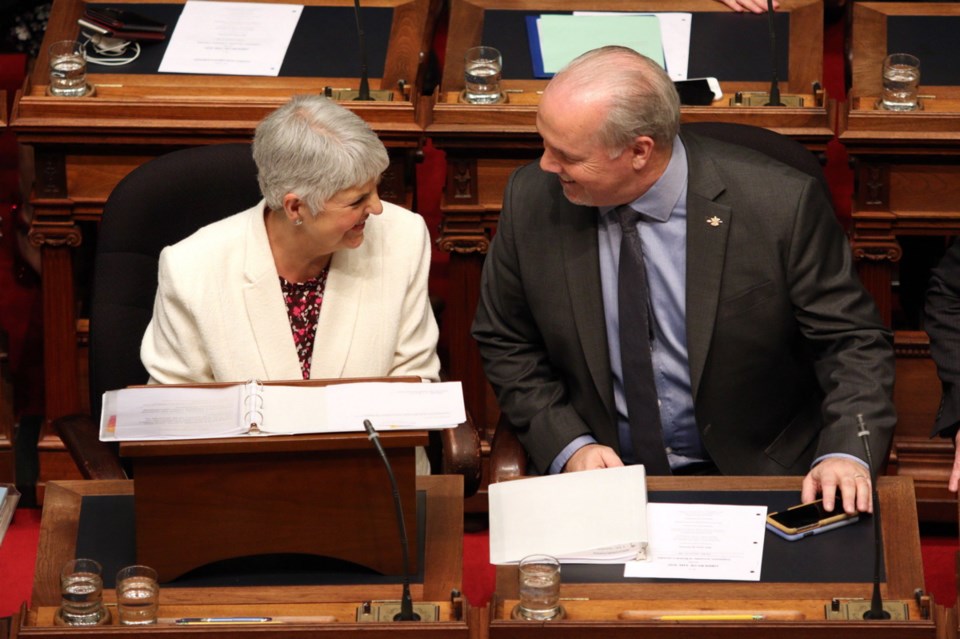 One of the core NDP beliefs is that the previous B.C. Liberal regime didn’t spend enough money on people.
One of the core NDP beliefs is that the previous B.C. Liberal regime didn’t spend enough money on people.
It ran “surpluses for surpluses’ sake,” Finance Minister Carole James reiterated Tuesday. It was uninterested in turning extra provincial revenue into supports for families.
So while they’re surfing a strong economy, optimistic growth projections (and the benefits of those Liberal surpluses), the NDP government unveiled a plan that involves spending nearly every nickel it can get its hands on while still balancing the budget to demonstrate its commitment to people.
Approaching the mid-term mark as a minority government, the NDP isn’t observing the traditional cycle of waiting until closer to the next scheduled election before handing out benefits.
James packaged up as many as she could and unveiled them Tuesday. There’s almost a billion dollars put down on climate-change measures — some of it in tax breaks — as the price tag for the CleanBC plan already outlined.
Another $3 billion is committed to First Nations over the next generation by way of a guaranteed slice of gambling revenues.
There are significant enhancements to health spending, including elimination of Pharmacare deductibles for a quarter-million low-income families.
And the marquee item is the new child opportunity benefit. It will supply all but the highest-income families with significant new child-based monthly payments that will run clear through until adulthood.
Parents who fret about their children amounting to something can worry no more. Their tykes will start bringing in the big bucks late next year, when B.C.’s monthly contribution to their welfare is going up sharply.
The child opportunity benefit got one of the lengthiest advance billings ever in a budget. It won’t arrive until October 2020, but it’s the highlight of the spring 2019 budget. The timing suggests the government isn’t completely confident about going the full term.
It’s part of a package that James said would amount to the biggest collective break the middle class has received in a generation.
It will cost $250 million in the first full year, on top of child benefits announced last year.
A $50-a-month bump in income assistance rates and hikes to disability rates are worth another $100 million a year. Interest on student loans is being eliminated, at a cost of $30 million a year. Program improvements for foster children and children in care will be worth another $30 million a year.
Those programs are loosely grouped under the heading “creating more opportunities for people to get ahead” and they amount to $860 million over the next three years.
While the opposition Liberals were left fuming about “where all this money is coming from,” James can claim clean hands when it comes to tax hikes.
“There are no new tax measures that increased provincial government revenues,” according to the fiscal plan. A carbon-tax hike this April stems from a previous budget.
Liberals partly answered their own question by pointing to a $1.6-billion one-time windfall in federal transfers.
The double-tap on medical premiums this year — when the government collects one last year of reduced premiums even as the employer health tax kicks in, also brings in more cash. As does the general increase in the take from most existing taxes as economic growth continues.
Over the longer term, the NDP cited the liquefied natural gas plant near Kitimat as another revenue generator. But that wasn’t enough to put off Green Party Leader Andrew Weaver, who committed his caucus’s balance-of-power support to the plan right after it was delivered.
“B.C.’s fiscal picture is strong and getting stronger every day,” the budget documents say.
Optimistic economists have all lined up to endorse the growth projections.
All the usual risk factors apply. But there are two key local ones that raise flags about the NDP spending plan.
One is that natural-resource revenues are forecast to average a seven per cent annual decline over three years.
The other is real estate. James said the moderation in the market to date is “exactly the approach we were looking for.”
But housing starts are forecast to drop 25 per cent over the next few years, and real estate revenue to government is flat-lining. Ensuring “moderation” doesn’t turn into a sharp downturn will be one of the keys to establishing how much the NDP can afford to care about people.



